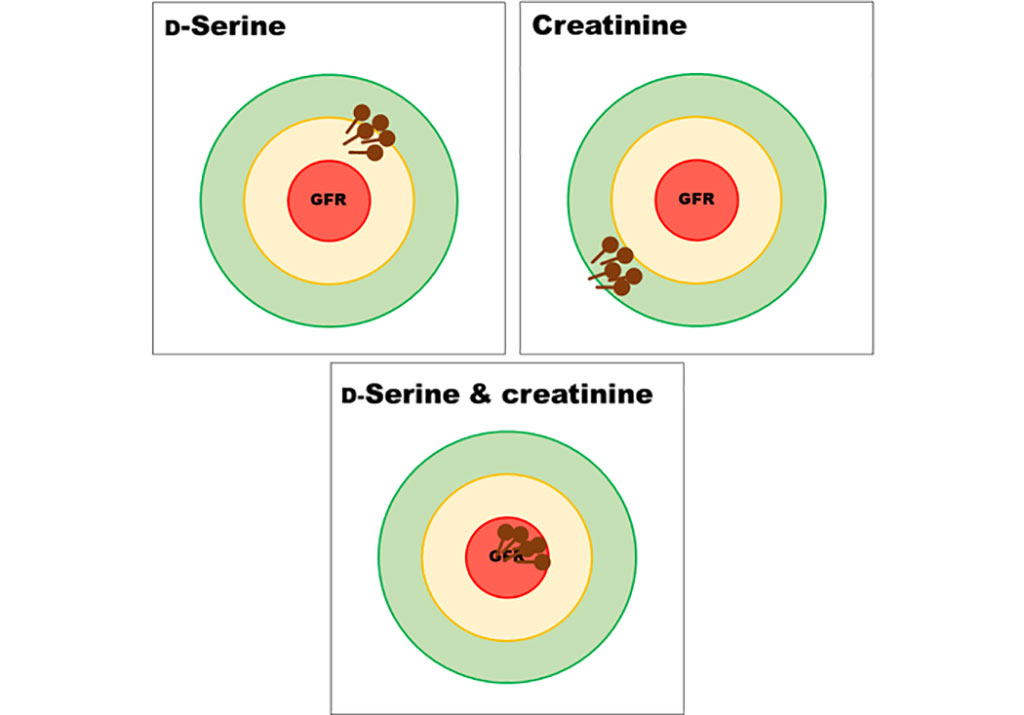D-Serine Clearance Evaluates Precise Measurement of Kidney Function
By LabMedica International staff writers
Posted on 21 Dec 2021
Evaluation of kidney function is essential in daily clinical practice. The measured glomerular filtration rate (mGFR) using exogenous inulin has been considered as the gold standard of kidney function, though this procedure is labor intensive, time consuming, and expensive.Posted on 21 Dec 2021
D-Serine is a candidate biomarker of kidney function. D-Serine circulates the bloodstream in the body and is delivered to the kidney. D-Serine is then filtrated through the glomerulus and excreted in the urine. When kidney function is impaired, the urinary excretion of D-serine decreases, and its blood level increases.

Image: D-Serine is useful for the measurement of glomerular filtration rate (GFR). The clearance of D-serine has an advantage of lower bias against GFR compared to that with the creatinine clearance. Combinational clearance measurement of D-serine and creatinine can serve as a measure of GFR with precision and low bias (Photo courtesy of Tomonori Kimura, MD, PhD)
Medical Scientists at the Osaka University (Osaka, Japan) and their colleagues carried out a cross-sectional observational study of 200 living kidney transplant donors and recipients enrolled between July 2019 and December 2020, for whom GFR was measured by clearance of inulin (C-in).
The clearance of D-serine (C-DSer) was calculated based on blood and urine levels of D-serine, as measured by two-dimensional high-performance liquid chromatography. Analytical performance was assessed by calculating biases. Utilizing data from 129 participants, the team developed equations for C-in based on C-DSer and C-cre using a linear regression model, and the performance was validated in 68 participants. Creatinine in serum and urine was measured enzymatically (Determiner L CRE, Hitachi Chemical, Tokyo, Japan), and serum cystatin C (sCys) was measured using an immunological turbid metric assay (Nescoat GC Cystatin C, Alfresa Pharma, Osaka, Japan).
The investigators reported that in the overall cohort, the mean values of serum creatinine, cystatin C, and plasma D-serine were 0.86 mg/dL, 1.1 mg/L, and 2.3 μM, respectively. The mean clearances of inulin, creatinine, and D-serine were 66.7, 98.2, and 55.7mL per minutes per 1.73m2 of body surface area, respectively. The levels and clearances of D-serine in plasma and serum were almost identical and so they used plasma level of D-serine in the analysis. In the total cohort population, C-DSer was significantly and strongly correlated with C-in (R = 0.91), like C-cre (R = 0.93). Remarkably, the clearance of D-serine agreed well with GFR. The low bias as a measure of GFR was an advantage for the D-serine clearance. The degree of bias against GFR was smaller than that of the creatinine clearance. Additionally, the combinational analysis of clearances of D-serine and creatinine could measure GFR with high performance.
Tomonori Kimura, MD, PhD, the senior author of the study, said, “D-Serine turned out to be of great clinical importance. D-Serine may solve the problem of kidney disease with more than 800 million patients in the world. Measuring D-serine is applicable in a wide range of clinical fields and for drug development.”
The authors concluded that the combination of C-DSer and C-cre can measure the GFR with precision and minor biases. The current method using endogenous molecules may reduce clinical burdens for measuring GFR. The new method is precise across the tested range of GFR and has the potential to facilitate key clinical decisions in various clinical situations. The study was published on December 4, 2021 in the journal EClinicalMedicine.
Related Links:
Osaka University
Hitachi Chemical
Alfresa Pharma













